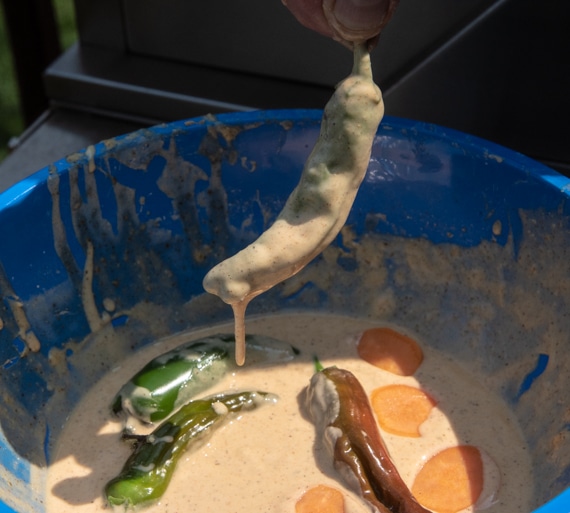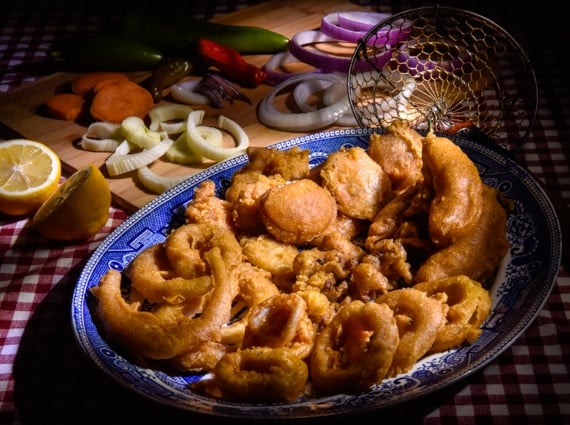Tempura batter is light, lacy, and ultra crispy. It is ideal for deep frying vegetables and seafood. Here, we give our tempura beer batter recipe.
When I’m frying chicken, I prefer to dredge it in flour and shallow fry it rather than battering and deep frying it. For seafood and veggies, however, I like a beer batter or tempura batter (they are very similar). Batters coat food more evenly and make a thicker coating. They are wet, so it takes longer for the oil to drive off all the moisture. But in that time, steam bubbles up in the batter, making the finished coating lighter and crispier. Carbonated liquid such as beer in the batter makes it froth even more in the oil, creating a lacier finish.
J. Kenji Lopez-Alt of SeriousEats.com preaches substituting some of the beer with vodka because it evaporates faster during frying, and I am a Kenji acolyte. The vodka also inhibits gluten formation in the batter and that keeps the mixture liquid longer as you are working with it. The alcohol in the beer and vodka is driven off during frying. But if you must, you can substitute club soda or seltzer water. Just don’t use anything with sugar in it. And before you start battering and frying, read my article on frying here because it’s soooo much better to fry on the grill.
Tempura beer batter recipe
Makes:
Takes:
Equipment
- 1 Dutch Oven or Large Pot
Ingredients
For Frying And Serving
- Enough vegetable oil to fill a Dutch oven 2-3 inches deep
- 6 cups vegetables, or 3 to 4 pounds of seafood
- Coarse salt for serving
Dry Ingredients For The Batter
- 2 cups cake flour
- 1/2 cup cornstarch
- 1 tablespoon Morton Coarse Kosher Salt
- 2 teaspoons baking powder
- 1/2 teaspoon baking soda
- 1 teaspoon onion powder
Wet Ingredients For The Batter
- 2 large eggs
- 12 ounces beer or club soda
- 4 ounces 80 proof vodka
These recipes were created in US Customary measurements and the conversion to metric is being done by calculations. They should be accurate, but it is possible there could be an error. If you find one, please let us know in the comments at the bottom of the page
Method
- Prep. Chill the beer or club soda. Cold temps help prevent gluten formation.
- Mix the dry ingredients in a small bowl. Beat the eggs lightly in a large bowl. Add the rest of the wet ingredients to the eggs and stir. Pour the dry ingredients into the wet and stir but don’t mix aggressively as you don’t want to form gluten. Some clumps of dry flour should still be floating around in the batter, and the consistency should be a bit thinner than pancake batter. When you dunk something in it, the batter should coat the food thoroughly as excess batter gradually drips off. The batter should not be so thin that it immediately sheets off the food. If you need to thicken it, gently stir in more flour. To thin it, add beer, club soda, or water.
- Fire up. Preheat a 2 inches of oil to 325°F in a Dutch oven on your grill.
- Dunk the vegetables or seafood into the batter. Stir until coated. Note that if you are frying peppers or other pods (like okra), poke some holes in them so they don't explode.

- Cook. With tongs, pull the vegetable or seafood out, let some of the excess batter drip off, and slip the vegetables or seafood into the oil. Try to cook pieces of similar thickness together so they are done at the same time. Do not crowd the pot or the oil temperature will drop too low. Try to keep the oil temp above 325°F (163°C). Flip the vegetables or seafood often and fry until the batter is pale golden in color, 1 to 2 minutes. If you are doing chicken this way, fry until the white meat reaches an internal temp of 160 to 165°F (71° to 74°C) or the dark meat reaches 170 to 175°F (77° to 79°C). Don't worry about the internal temperature of veggies and seafood. They will be safe when the batter is golden. When done, lift the food out with tongs or a spider strainer and spill them onto the grate or paper towels to drain and drip dry for a minute or two.
- Serve. Sprinkle with coarse salt and serve. Scoop out any bits of fried batter left in the oil before the next batch goes in. These crunchy bits are called tenkasu and can be used in sandwich wraps, as toppings for noodle dishes, and as garnishes for soups.



High quality websites are expensive to run. If you help us, we’ll pay you back bigtime with an ad-free experience and a lot of freebies!
Millions come to AmazingRibs.com every month for high quality tested recipes, tips on technique, science, mythbusting, product reviews, and inspiration. But it is expensive to run a website with more than 2,000 pages and we don’t have a big corporate partner to subsidize us.
Our most important source of sustenance is people who join our Pitmaster Club. But please don’t think of it as a donation. Members get MANY great benefits. We block all third-party ads, we give members free ebooks, magazines, interviews, webinars, more recipes, a monthly sweepstakes with prizes worth up to $2,000, discounts on products, and best of all a community of like-minded cooks free of flame wars. Click below to see all the benefits, take a free 30 day trial, and help keep this site alive.
Post comments and questions below
1) Please try the search box at the top of every page before you ask for help.
2) Try to post your question to the appropriate page.
3) Tell us everything we need to know to help such as the type of cooker and thermometer. Dial thermometers are often off by as much as 50°F so if you are not using a good digital thermometer we probably can’t help you with time and temp questions. Please read this article about thermometers.
4) If you are a member of the Pitmaster Club, your comments login is probably different.
5) Posts with links in them may not appear immediately.
Moderators